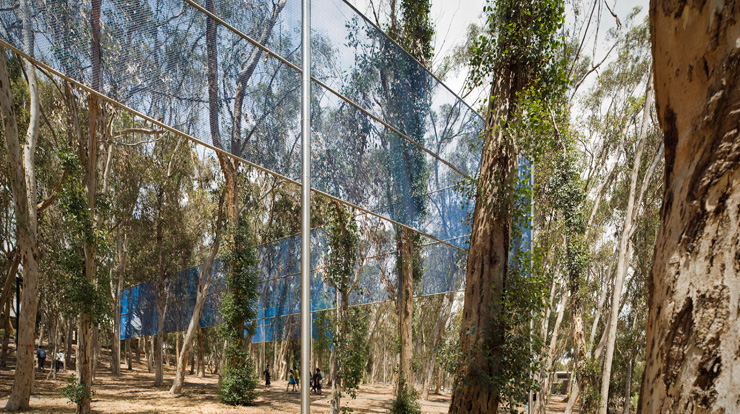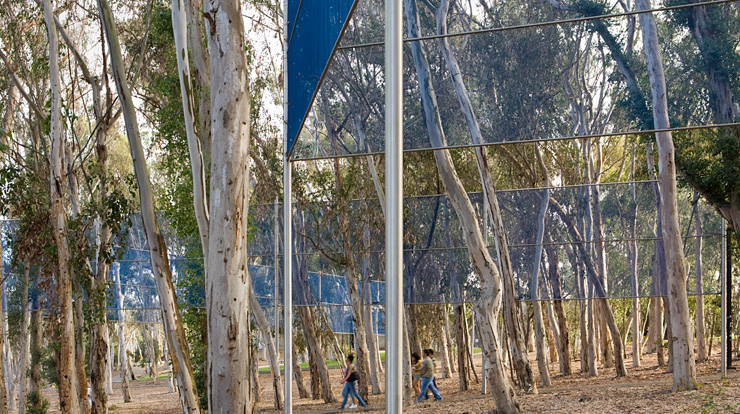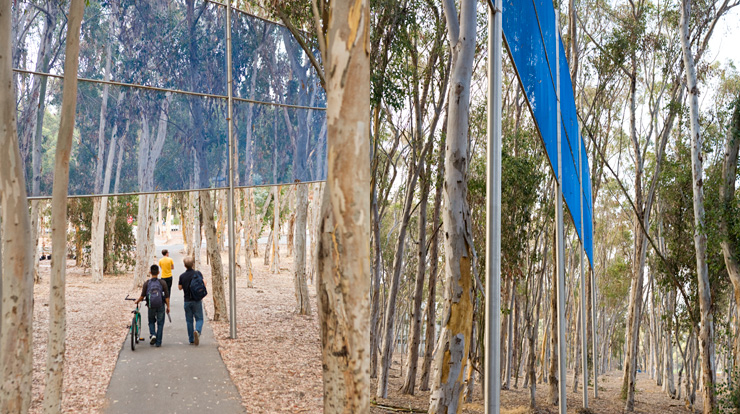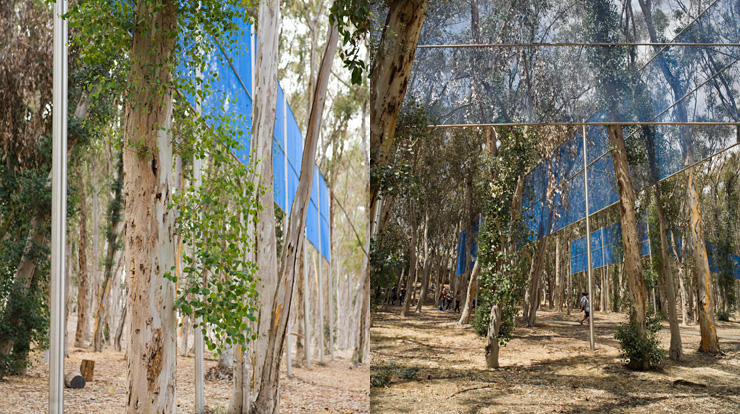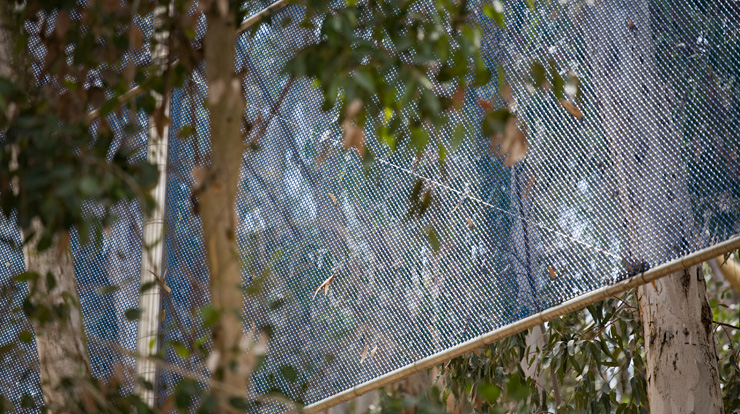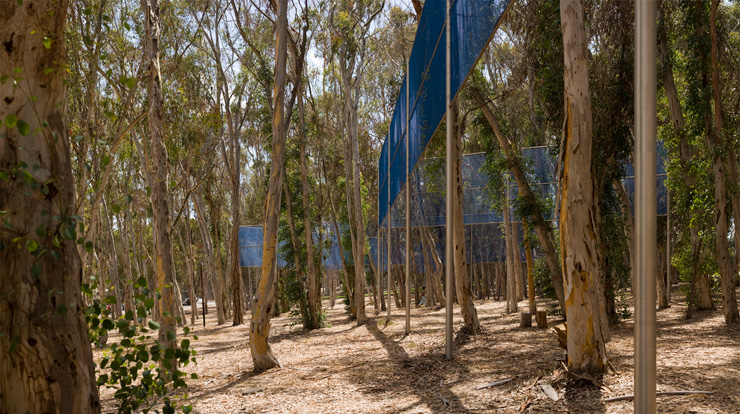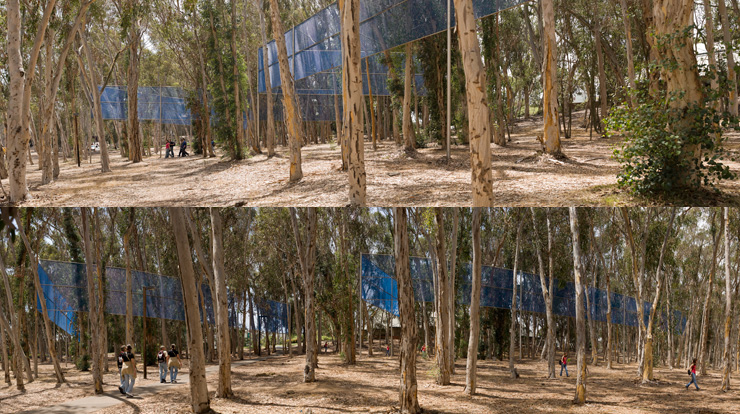Robert Irwin
Two Running Violet V Forms (1983)
Location: eucalyptus grove between Faculty Club and Price Center
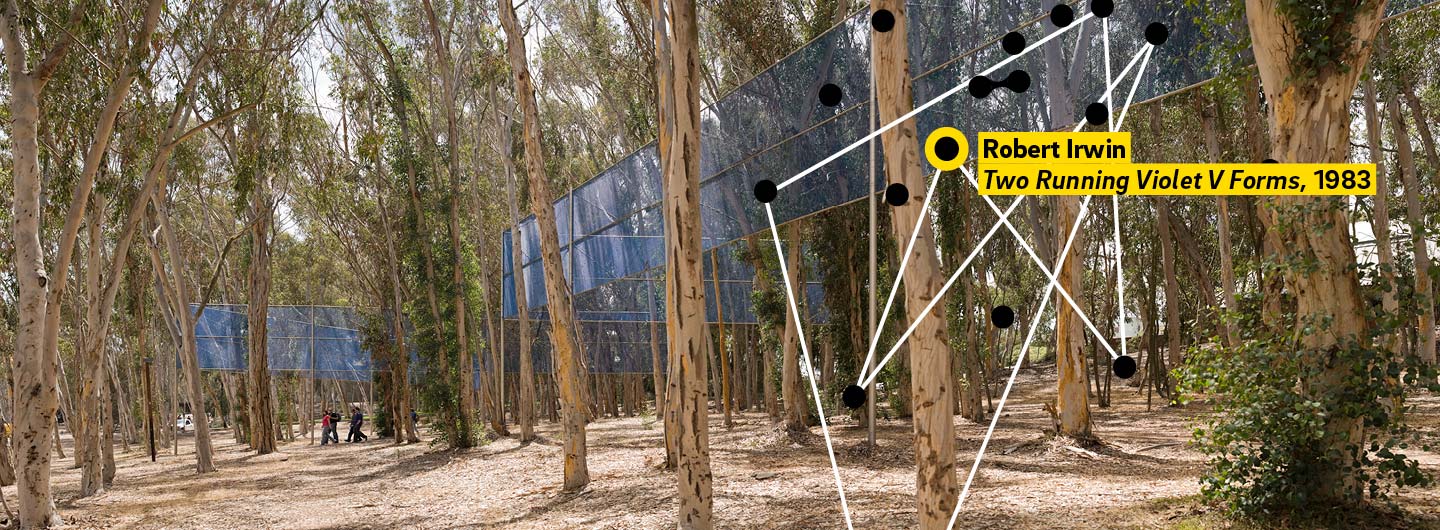
Robert Irwin 1928 - 2023
Robert Irwin, pioneer of Light and Space Art, provoked viewers into an awareness of their own processes of perception, as well as their expectations of art. His immense legacy to art will continue to resonate here at UC San Diego through the eucalyptus groves where his artwork, Two Running Violet V Forms, emphasizes the infinite variety of light and color.
Robert Irwin, Artist of Fleeting Light and Space, Is Dead at 95
Part of a bold, experimental 1960s movement, his work sought to make viewers active participants in their experience of encountering art.
Robert Irwin, pioneer of Light and Space art who designed Getty’s Central Garden, dies at 95
Irwin made site-conditioned outdoor installations for diverse locations, including UC San Diego.
About the Artist
Robert Irwin began his career as a painter in the late 1950s in California. In each series of canvases during the 1960s Irwin questioned the fundamental characteristics of his medium: the nature of the painted mark, the quality of light, and the limitations of the canvas itself as a bounded, rectilinear support. This process of inquiry led him to give up painting altogether by 1970. Irwin decided to respond to situations, rather than produce autonomous works of art in the isolation of his studio. These ideas led to several architectural installations in museums and other sites that provoked viewers into an awareness of their own processes of perception, as well as their expectations of art.
Robert Irwin was the recipient of a prestigious MacArthur Foundation award in 1984. In 1992, he was commissioned to create the Central Gardens at The J. Paul Getty Center in Los Angeles. In 2000 Irwin redefined an old Nabisco factory into the Dia:Beacon Art Center in Beacon, NY. He lived in San Diego until his death in 2023.
Epilogue
From: Being and Circumstance, Notes Toward a Conditional Art
by Robert Irwin, The Lapis Press, Larkspur Landing, CA
The wonder of it all is that what looked for all the world like a diminishing horizon - the art-object's becoming so ephemeral as to threaten to disappear altogether - has, like some marvelous philosophical riddle, turned itself inside out to reveal its opposite. What appeared to be a question of object/non-object has turned out to be a question of seeing and not seeing, of how it is we actually perceive or fail to perceive "things" in their real contexts. Now we are presented and challenged with the infinite, everyday richness of "phenomenal" perception (and the potential for a corresponding "phenomenal art," with none of the customary abstract limitations as to form, place, materials and so forth) - one which seeks to discover and value the potential for experiencing beauty in everything
About the Sculpture
For his contribution to the Stuart Collection, Two Running Violet V Forms (his first significant installation in California) Irwin was drawn to the eucalyptus groves so characteristic of the campus. The contradiction inherent in this manmade forest appealed to him; the geometric regularity of the grid of trees is balanced by the infinite variety of light and detail that the natural setting nevertheless provides. Irwin installed two fencelike structures in V-forms amidst the trees. The "fences" are blue-violet, plastic-coated, small gauge chain-link fencing supported by stainless steel poles that average twenty-five feet in height. The structure maintains a constant elevation as the hillside terrain drops gently beneath it. A sprinkling of purple flowering ice plant, echoing but not matching the color of the chain link, is planted under the fence.
At no point is the fence an obstacle; rather it acts as a screen reflecting the changes in light throughout the day and the year, the moment and the season. Its gentle introduction of industrialized geometry recalls the unnatural grid that organized the grove, and suggests a sensual intrusion into the forest. For people who walk the grove's various paths, Irwin's sculpture provides an ever-changing perceptual experience - sometimes dramatic, and sometimes so modest it seems to disappear.
Essay
Robert Irwin, Two Running Violet V Forms, 1983
The Stuart Collection Advisory Board held Robert Irwin in high esteem, and from day one his work seemed the perfect choice to follow Niki de Saint Phalle’s Sun God. We wanted to demonstrate right away the wide range of possibilities for commissioned work using the campus as a canvas. Although Bob had won a number of commissions, for a variety of reasons none had come to fruition. He had never built a permanent work in his home state. (This was notable since, in 1984, he was to become one of the first artists to receive a MacArthur Fellowship, the so-called “genius award.”) Yet Bob is the quintessential California artist. Born and raised in Los Angeles, growing up immersed in car culture and swing dancing, he made an early decision to be a painter. But his interest in both the act and the results of painting waned; and as it did, his fascination with everything going on outside the picture frame grew. Compelled by inquiry on the nature of perception, light, and space, he began to address place. Moving away from the realm of the object, he began taking the viewer—and himself—into new territory.
Bob first visited the UC San Diego campus in November 1981, a month after I arrived as director. He was immediately enthusiastic about the possibilities. Bob is an energized presence, a friendly, forceful personality. At the Portland Center for the Visual Arts, he had created one of his transforming scrim installations, visually and perceptually extending a 5,000-square-foot gallery space with very few gestures. I was excited about working with him again, and especially interested in what he might do in this new context.
Bob went right to work exploring the campus, sensing it as territory and watching the way people moved through it. He responded particularly to the many eucalyptus groves scattered around, and to the relief they offered from the more corporate aspects of the campus landscaping. Their shade, their fresh aroma, their play of light and shadow, and their soft color all appealed to him greatly, as did their geometric arrangement. They are a dominant feature of the campus, giving it a sense of place unique among the ten University of California campuses.
By 1981, the university was launching a period of serious expansion, and to make room for new buildings some of the eucalyptus groves were being cleared. Somewhat later the destruction of these groves became an issue, but Bob noticed it early on. He envisioned a work that would be a catalyst for thinking about the sensory qualities of the space and the light in the groves, and that would invite people to experience these places. This in turn, he felt, would propel both their appreciation of the groves and their awareness of their own powers of perception— an enduring Irwin subject.
Bob chose a centrally located grove with several major pathways running through it, a natural place to engage people walking through in their daily course of activity—trafficked in the minutes between classes, with a surge of students and faculty making their way along them hourly. Just as quickly, the paths become quiet again. Irwin liked the fact that people traversed the grove when they weren’t necessarily thinking about art, encountering the place in an informal way.
In January 1982, Bob presented a proposal to the members of the advisory board who lived nearby and could gather on the grove site: Jim DeSilva, Patrick Ledden, Newton Harrison, and me. He planned a high fence of small-gauge, blue-plastic-coated chain link stretched between five-inch-diameter stainless steel poles with a brushed finish, the height of the poles varying with the slope of the hill to keep the fence level. The fence would be installed in two separate lengths, each in the shape of a V. Not designed to keep anybody out, it would begin a minimum of nearly nine feet above the ground, obstructing no one’s passage. Below it would be planted a scattering of ice plant, which flowers in lavender blue.
The review group’s considerable enthusiasm led to a telephone canvas of other members of the board, and the proposal was approved. Bob’s energy and attention were then entirely focused on the project. He engaged Jack Brogan, a master technician and friend, to handle engineering and construction. Bad weather and late shipments of steel from Korea caused delays, but in time eleven-foot-deep holes were drilled and filled with concrete and rebar as supports for the poles. Not a single eucalyptus branch was damaged during construction, and the installation was completed by November—that is, the first version was.
This was not a work that could be assembled and built in the studio, then assessed and adjusted before installation. In late 1982 Bob called Jim DeSilva, Pat Ledden, and me to meet again at the site. Feeling that the pair of V forms felt too much like two separate works, one on each side of the path, he had decided he wanted to extend each section by about fifty feet—one across the path, the other farther into the grove. Although the work looked fantastic as it was, we agreed that the additional lengths would take it to a new dimension, substantially intensifying the experience and further integrating the work with its context.
We were committed to realizing the artist’s concept and making the work as good as it could possibly be. My only concern was that extending the fence over the path might tempt someone to swing from the bottom horizontal bar, about nine feet above the path; but we went ahead anyway, and it has never been a problem. Right after the entire work was installed but before the opening, the fence stared sagging badly because of the distance between the poles. Jack Brogan designed a solution using sail-rigging-type wire stays, which have held up without even minor modification. Told that it would be impossible to grow anything beneath the eucalyptus trees because of the eucalyptus oil, we installed a watering system and went ahead with the plantings of purple-flowering ice plant. It still blooms from January until about April, becoming part of the ever-changing scenario in the grove.
Two Running Violet V Forms was completed and celebrated at an opening in May of 1983. Some months later a notable intervention occurred on the site of another campus eucalyptus grove—which, without any public warning, was cleared for the construction of new buildings. All that remained was a field of perhaps 100 stumps about eighteen inches high. Responding immediately, students made visible their concern: the next morning, each stump had a white Styrofoam cross set upright on it, suggesting a ghostly cemetery. The statement was short-lived but moving.
Bob’s work is man-made of industrial materials. It is juxtaposed with nature and it gently integrates itself with the grove. Here, humanity and nature coexist, not competing, not dominating one another, each playing off the other. The fence is anything but static—it is a living, breathing part of the grove. It does not announce itself as art, but exists, sometimes waiting quietly to be noticed, sometimes softly saying, “Look at me.” As visual experience, it is abstract, but underplays connections to any pre-existing body of knowledge one might have.
The piece has no formal beginning or end, but walking on the path that passes under it allows perfect entry into the experience. As one walks and looks, the blue changes, whether dramatically or softly. The open mesh of the chain link can appear opaque at moments or in stretches and transparent at others. As one looks up, the shadow of foliage plays on the blue in the sunshine. One sees branches through it and around it. Sometimes it seems that a ribbon of sky has been woven through the grove. It sparkles after a rain, becomes poetic and mysterious in fog, and on a bright day it can be positively operatic. In February and March, monarch butterflies flutter about from their brief winter-nesting spots in the closest trees. We think the color attracts them. The poles are in scale with the trees, and gray like their bark. As one walks through the grove, they appear and disappear in the trees, just the way people do.
The response has been mixed from the start. The work has been mistaken for scientific apparatus or for athletic equipment. Bob is pleased by all this, and the university is well served by the dialogue, conversation, and even classroom assignments generated by its presence.
Every artistic decision in this work is based on qualities that preexist and continue to exist. The place has stayed the same, but now, season to season, day to day, moment to moment, a heightened awareness of light, birds, flowers a cloud, a shadow, a breeze, all participate in—and contribute to—the pleasure, beauty, and awakening one can find here.
Interview with the Artist
Robert Irwin Interview with Joan Simon
Joan Simon: I guess a good place to start is, how did you start developing the ideas for the Stuart Collection project?
Robert Irwin: I walked the campus, which is what I always do. I just walk around and spend a lot of time there. And I don't try and do a project in my head while I'm there; I basically just look at the site and try and get a feel for the place. And after I go away, then I think about how I feel about the place and so forth. And then I go back.
In this particular case, to me, I felt the architecture and the layout of the campus, there was nothing really special about it—nothing except the stands of eucalyptus trees. To me, that's what you remember. It’s the one thing that distinguishes that campus. They’re quite beautiful. You spend a little time in them, and they really evoke an interesting mood. So, the first thing was, if I do something on campus, I'd really like to do something in the area of those trees, or something in relationship to those trees.
Also, everybody passes through them. They’re not hidden away, or some place you'd take a trip to; you go through them every day going back and forth from classes. And there is a bit of habituation that goes on, naturally; not everybody pays too much attention, they've got a lot of things on their mind. So the initial part of the idea was to somehow take what is going on there, and just sharpen it into a focus a little bit. Also in the back of my mind was the idea that if I did something in those trees, it could point up their importance. It might remind everybody that they've something special here.
So then I came down with the question of OK, what can I do in this space? And the first thing was—it's not at ground level, it's not at eye level, it's up in the air. It's a soaring kind of thing, and it's happening up above you. And the idea of coloration was quite interesting—that every time you walk through those stands of trees at different times of day, they are a different color. They go from almost a nondescript gray to violet and to green, and they get a kind of golden quality at certain times of day, from the sunlight. So the idea also was sort of to heighten that experience of the color.
It was the first time I used that chain link fence material, which I didn't know about when I got involved in the project. I did some research, looking for something that had the ability to affect a lot of space but was not something you focused on, was not a thing in itself; and that fence material from a little bit of a distance becomes just a visual haze of color. It was a terrific material to find. The color is quite quixotic. I say that because the day I was finishing it up, I was looking at it and it was almost not there. I mean no color at all. And I thought, oh Jesus, I've screwed up. But that's the funny thing about it. Sometimes the color is intense, really strong, and then sometimes it's not there at all. Which is fine. It sort of did the same thing that the color in the trees does.
And so everything else was really how to articulate all that space, and to get it up in the air, and to play with the quality that was already there, and really to add as little as possible. The stainless steel poles worked well, because they wear well. They're going to last, I don't know about forever, but for a very long time. And they patina with being in the space and get a comfortable look in there. And they're not all that visible—I don't think they're that demanding in and of themselves. And the idea was working out how to do that in the simplest, most economical way.
The plant material at the bottom was an idea that came at the end. I thought it would be nice—the piece could live without it, but it would be nice if it could be there, which it is, on occasion. And it's sort of like the color falling down to the ground, and gives the whole area a bit more life.
It's really a simple piece, and it was really a very simple process.
JS: The idea of working outdoors relates to several projects and exhibitions of 1977: the photo piece New York Projections, Rectangle-Mercury-Vapor Lamps, Central Park, and unrealized proposals of the same period like the one for seeding vacant lots with wildflowers in a ten-block area in LA. Were these the beginnings of your garden/park situations?
RI: Maybe, but not in a causal sense. First of all, when I did the discs in the late ’60s, I realized that what I was really interested in was phenomena. At that time, I had an extra room in the studio, and I painted the whole thing white, I covered all the corners, and I made it as close to like a Ganzfeld effect as possible. And then I started putting just a single light in there—a fluorescent light or an incandescent light, a floodlight or a spotlight. I borrowed or rented basically everything that was being made at that time, and I put them all in there one at a time, looking at the quality of the light. What I was looking for was in some way to engage the phenomena, and the problem is we are very object-oriented. Every time I put a picture there, it did a lot of interesting things, but for someone just walking in, the presence, the phenomenon, was very subtle. You’re preconditioned to look at the object as the thing.
I was also looking for other materials and it was then that I found the scrim quite by accident. I was doing an exhibition in Amsterdam, and this material was on almost every window. It was fascinating what it did with the light. I thought, that's beautiful stuff. The amazing thing was that it came fourteen-foot wide instead of three foot or four foot, which is what most material comes in, and so suddenly I'm like, wow! Again, I'm going back to light, to some way to affect space without it being a thing, without having any objectness to it. So that's how the scrim came into play. I wish I could have found five things that would do that.
JS: The chain link fence at that scale does it.
RI: Exactly. For that outdoor situation it worked perfectly. It’s called non-climbable fence—it was made as a security fence, because you can't get your fingers or your toes into it. Normal chain-link fence has two-and-a-half-inch apertures; this has three-quarters of an inch, or five-eighths. That makes all the difference in the world.
JS: At which point did the plant material come into the project?
RI: Near the end. It was a refinement, the piece would work without it. You have a major limitation: basically nothing grows under eucalyptus except ice plant. It takes some doing to get it to grow, but it will.
JS: A number of unrealized proposals from the same time as this piece used plantings.
RI: The easiest way to explain that is: you're outdoors, you're trying to affect this large space, and you have $1.95 to work with, which is how it always is. One thing that’s important outdoors is scale. Something big enough to engage the space—that's certainly one strategy. And for $5,000 you can buy a really great tree, something forty-five feet tall and thirty-five feet around, and it has a tremendous effect on the space. And scale being my first cognition, I thought, my God, if I build something as big as that tree in any other material it’ll cost $150,000, and here I can do it for $5,000.
Of course, having done that, you start being affected by color. I had wanted color back in my work for a long time; I just didn’t know how to legitimately get it in there. As a painter, I’d loved the way color is when it’s made up of five thousand points of light, as opposed to a couple of strokes of paint. It’s simply not the same. The color in nature is so much more complex, and when you start to get into the phenomena of color, each single point of color goes through a shading from light to dark, from violet, say, to its opposite, and that’s what really makes it. In a painting, if, for example, you want an important element of red, you have to put green in somewhere, because the eye habituates to red in less than twenty seconds and mutes it. So if the eye isn’t re-energized by the green, the red painting is never really red. But in nature that’s there all the time. When you see orange in nature, with all the ambient blue around that orange, it is just whammo.
JS: You said that one of the key aspects of the eucalyptus grove was its criss-crossing paths—
RI: Yes, I loved the fact that people come upon it naturally. It’s not like going to a museum, it's not like being channeled or focused, there's no ritual involved. You just walk through and say, “What the hell is this?” The idea in a sense is that you pass through the piece in your normal movement through the campus. If somebody had to go find it, like a trek to Mecca or something—for some people those things are ablutions, ceremony, and ritual and so forth, but for me they’re distractions. I’m interested in that “Aha” moment that probably every one of us has had, and which is why we’re interested in art in the first place. We’ve experienced something that knocked our socks off. And from that point we want to know. We seek it out. We find it. We pursue it. What I try to do is create an uncluttered moment where you can have that little confrontation with yourself.
JS: At other times you've called it “wonder.”
RI: “Wonder” is a great word, because in philosophy, wonder is what allows you to deal with the unknown.
JS: You have written of attending as the equal of discovery (see note). That seems crucial.
(note: "We do not invent our consciousness. Here attending is the equal of discovery, since by the time we can conceive of a change the grounds for it are already in us." Robert Irwin, "The Myths of the Art World," in Irwin, "The Hidden Structures of the Art," published in Robert Irwin, exh. cat. (Los Angeles: The Museum of Contemporary Art, and New York: Rizzoli International Publications, 1993), 27.)
RI: It is crucial, just in terms of how the mind works: we see what we seek to see. So that moment of attending the world is probably the single most important force in the world. How you enter in is by essentially doing just that—opening yourself up and attending it. And if you don't allow yourself that moment, if you just bring all the baggage with you, then you never actually know what's literally there. You're always structuring it, or pre-structuring it, or having ambitions for it. The rationales we have as we function in the world are important, but they obscure the individual moment of understanding. The only act in a sense that puts you in that position is to attend directly to the nature of things.
JS: Talking to Lawrence Weschler about the “historic relationships between a sculpture and its site,” you began by discussing site-dominant works and followed through to site-generated pieces (see note). This idea is important not only to your own process but to the Stuart Collection.
(note: Lawrence Weschler, Seeing Is Forgetting the Name of the Thing One Sees: A Life of Contemporary Artist Robert Irwin (Berkeley, Los Angeles, and London: University of California Press, 1982), 194.)
RI: While my painting was going down to, as someone else coined the phrase, "point zero”— down to less and less things—people were saying, Where will you go from here? And I didn't have any idea. At one point I thought the term ”non-objective” was going to translate to nonobject, this idea of the phenomenon, but all of a sudden I discovered that it had nothing to do with object/non-object at all; it had to do with the relationships, and the whole idea of conditioned relations. Everything exists as a set of conditions. Everything is acting on and in a context. When I move an object from one point to another point everything is changed. So that became the development of this, that the key in classical thought was how the object was understood in a meaningful context. In site-dominant sculpture, the object was in a sense the content or the container of a meaningful idea or personage, and on the basis of that it dominated, and was therefore placed in the center of the plaza. It was given this hierarchical position of power. And the whole history of modern art has been the deletion of that power, disseminating the whole hierarchical structure.
JS: You give as an example of site-dominant work the sculptor Henry Moore. You also talk about site-adjusted works, by people like Mark di Suvero.
RI: Simply, that is when the object loses its immediate meaningful context. When we made a so-called “abstract” painting, a lot of people wanted to Rorschach or psychoanalyze it, read meaningful context into it. Docents in museums say to kids, "What do you see in there? Is there a cloud, a cow jumping over the moon?" But the whole point was, content was giving way to presence. The work was not about content; it was not about a referential process at all. It was an immediate presence that you were being asked to attend. And once you do that you have someone like Mark di Suvero, an abstract sculptor. He's still an object maker, still making a thing, but he’s not making it in quite the same sense, because he will begin to deal with scale or color as independent elements. When you first did an abstract expressionist painting, when a dot was not a molehill but a dot, and a splash was not a mountain, but a splash, then you start dealing with a whole different issue of scale and relationships. So di Suvero starts making a sculpture that has some understanding of the physicality of the space that it’s in, but it’s still an object, still made in the studio and transported to the site, still having a style or a defined character. So that’s what I meant by site-adjusted.
And then there’s site-specific, which is really where the crucial step happens. Richard Serra speaks of site-specificity. He does, on occasion, move a sculpture from one place to another, but they’re made for a particular place. The crucial thing is, though, when you come to reference a work you still reference it in the old way, by referring it not to the experience, the moment of attending, but to the historical construct within which it stands—the history of artists, the history of art, the history of art objects, and what have you. So fundamentally there’s still this abstraction going on in terms of how we actually process it. What I’m saying about conditional relations is, if I did it properly, if I made a thing—it could be an object or not an object—but if I did something in a particular set of circumstances that was perfectly resonant with those circumstances, then as you come along you don’t have to know anything about me, and you don’t have to know anything about art.
JS: And those are the ones you would refer to as site-generated.
RI: I've been trying to find a word for it. Everybody loves “site-specific”; I've suggested two or three others. There was a great one in a quote from Mondrian.
JS: The one in the MoCA catalogue? (see note)
(note: Sally Yard writes, "Irwin’s thinking pursued that of Mondrian, who had suggested to no avail that the colors must be painted in the precise place where the work is to be seen, since seeing and light affect everything. In this theoretical break with the idea of the timeless, immutable object, Mondrian had laid the grounds for a conditional art of presence." Yard, "Deep Time," in Robert Irwin, p. 58. And note 28 (quoting Mondrian’s "The New Plastic in Painting").)
RI: It's like the guy, by 1912 or something, had predicted the whole damn thing in a way. He talked about the end of art as a thing isolated, and about conditioned relations. Here it is: “Nonfigurative art brings to an end the ancient culture of art…the culture of particular form is approaching its end. The culture of determined relations has begun.”
JS: Do you think your work has opened up questions for other artists, not only in the present but in the future?
RI: To predict the future is hard for me to do. But for me, I have posited in the world three or four questions. That show at the Whitney [Museum of American Art, New York, in 1977]—that whole thing was done to ask one question.
JS: Which was?
RI: Which was, if you take the words “experience” and “phenomena” and “aesthetics” as bearing directly on the dialogue of art, then can we take art to be the equal of making? And the answer in my mind is obviously no. If you accept that proposition, that changes everything: if art isn’t about making, it’s not about objects. It’s about perception, it’s about awareness, it’s about consciousness. Without being mystical-twistical about it, what art is really about is constantly extending the human potential to perceive and know and understand the world with an aesthetic bias.
JS: One of the ways you've done that is in your teaching. You’ve taught at Chouinard, at UCLA, and at UC Irvine; your students have included Larry Bell, Ed Ruscha, Vija Celmins, and Alexis Smith.
RI: The nice thing is that none of them work like me.
JS: Smith, in her interview for this book, talks about how important that time at Irvine was for her.
RI: Her Snake Path is terrific. She really pulled it off.
JS: How do you see the Stuart Collection as a whole, and how do you see it functioning in the future?
RI: This is the closest to a really good twentieth-century collection, or twenty-first-century collection, whatever you want to say. Basically, it's not a sculpture garden in the old sense of the word. A few pieces may be, you know, but they’re really integrated into the campus. Alexis’s is a good example, the flow of the whole campus moving into it. I haven’t seen a collection that is as good a forum as the Stuart Collection for taking up the questions of what is art or sculpture. I haven’t see anything that approximates it.
Folklore
The UCSD students have many legends about this sculpture. Some are even told as truth at freshman orientations or to gullible librarians willing to put them in print:
- The winter before the sculpture was constructed was very stormy and windy. When the students came back after spring break to see the sculpture, they thought it was put up to keep the trees from falling down.
- Another rumor had it that some giraffes escaped from the San Diego zoo. It seems (according to the same rumor) that giraffes really like eucalyptus leaves. The fences were put up to help capture the giraffes so they could be returned to the zoo. Even today, if you ask someone what the fences are, you might get "giraffe catcher" as an answer.
- Or they might tell you it's a volleyball net for giants.
